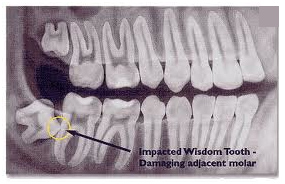 What Are Wisdom Teeth?
What Are Wisdom Teeth?
Wisdom teeth, or third molars, are teeth that develop last. They are called “wisdom teeth” because they usually appear during a person’s late teens or early twenties, which has been called the “age of wisdom.” The normal position of wisdom teeth is behind the upper and lower second molars.
Wisdom teeth can cause problems. Your last molars, called the third molars or wisdom teeth, typically begin to come in (erupt) during the late teens or early twenties. When they don’t have room to grow in properly, they are considered impacted. This can cause serious problems.
- A very painful infection, called pericoronitis, can affect a partially erupted wisdom tooth and the surrounding gums. This infection can spread into the face and jaw.
- When a wisdom tooth tries to erupt at an angle, it can cause decay in the neighboring tooth. This happens because wisdom teeth are nearly impossible to keep free of plaque, and the area between the two teeth becomes a trap for the bacteria in plaque that cause tooth decay.
- Additional bacteria in plaque cause periodontal (gum) disease, which may start near the wisdom teeth and spread throughout the mouth.
- A fluid-filled sac called a cyst may develop around an impacted tooth. A cyst can destroy a great deal of bone in the jaw before it’s noticed.
For most dental patients the best treatment for wisdom teeth is Wisdom Tooth Removal. This treatment helps prevent future dental problems and maintain a healthy mouth and smile.
To determine if wisdom teeth extraction is right for your situation, we’ll do a thorough examination, which typically includes x-rays.
It’s often better to remove wisdom teeth early, while their roots are still small, even before the teeth have come in through the gums. This allows for easier removal, fewer complications, and faster healing.
